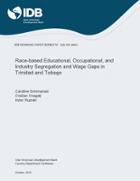Race-based Educational, Occupational and Industry Segregation and Wages Gaps in Trinidad and Tobago
Date
Oct 2018
As a result of its colonial history the labour market of Trinidad and Tobago is characterized by two majority racial groups of approximately equal number. During colonial times, these racial groups were highly segregated in terms of education, occupation, industry, and sector of work, and the institutionalized disparities in pay were large. This raises the question whether segregation and historical wage gaps still exist and are affected by the government in power. Using labour market survey data from 1999 to 2015, this study provides evidence of race-based educational, occupational, and industry segregation and wage gaps in Trinidad and Tobago’s private and public sectors and their development. Despite its history, aggregate racial educational and occupational segregation is low. With 7%, measured in terms of the KarmelMaclachlan index, it is even lower than respective gender-based segregation over the same period, and it has remained constant over the sample period. Furthermore, the findings suggest that most race-based occupational segregation is a result of prior educational segregation. In aggregate terms the racial wage gap was initially negligible but has been rising over time and shifting from initially favouring ATTs (citizens of Trinidad and Tobago of African origin) tofavouring ITTs (citizens of Trinidad and Tobago of Indian origin). There is, however, considerable heterogeneity in segregation and wage gaps across educational attainment levels, occupations, industries, and sectors. Race-based wage gaps appear larger in the public sector,
especially for women. Although we cannot control for all unobserved factors, there is also indicative evidence that the party in power affects the racial share of public sector workers and public sector wage gaps. Using quantile regression and decomposition techniques, this study
also provides evidence of large heterogeneity in returns to education and a shift in the direction of the average wage gap from favouring ATTs to favouring ITTs along the entire wage distribution.
especially for women. Although we cannot control for all unobserved factors, there is also indicative evidence that the party in power affects the racial share of public sector workers and public sector wage gaps. Using quantile regression and decomposition techniques, this study
also provides evidence of large heterogeneity in returns to education and a shift in the direction of the average wage gap from favouring ATTs to favouring ITTs along the entire wage distribution.




